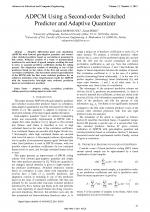| 3/2011 - 10 |
ADPCM Using a Second-order Switched Predictor and Adaptive QuantizerDESPOTOVIC, V. |
| Extra paper information in |
| Click to see author's profile in |
| Download PDF |
Author keywords
adaptive coding, correlation, predictive coding, speech processing, signal to noise ratio
References keywords
speech(11), coding(5), packet(4), loss(4), algorithm(4), adaptive(4)
Blue keywords are present in both the references section and the paper title.
About this article
Date of Publication: 2011-08-31
Volume 11, Issue 3, Year 2011, On page(s): 61 - 64
ISSN: 1582-7445, e-ISSN: 1844-7600
Digital Object Identifier: 10.4316/AECE.2011.03010
Web of Science Accession Number: 000296186700010
SCOPUS ID: 80055075779
Abstract
Adaptive differential pulse code modulation (ADPCM) with forward gain-adaptive quantizer and second-order switched predictor based on correlation is presented in this article. Predictor consists of a bank of predetermined predictors for each block of speech samples, avoiding the need to solve, or quantize predictor coefficients during the coding process. The adaptation consists of switching to one of this predictors based on the values of the first and second order correlation coefficients. The theoretical model is generalization of the DPCM with the first order switched predictor for an arbitrary prediction order. Experimental results for ADPCM with the second-order four/eight state switched prediction based on correlation are provided. |
| References | | | Cited By «-- Click to see who has cited this paper |
| [1] J. H. Chen, A. Gersho, "Gain adaptive vector quantization with application to speech coding", IEEE Trans. on. Comm., vol. COM-35, no. 9, pp. 918-930, 1987. [CrossRef] [SCOPUS Times Cited 41] [2] A. Gersho, R. M. Gray, Vector Quantization and Signal Compression, Kluwer Academic Press/Springer, 1992. [3] V. M. Despotovic, Z. H. Peric, L. Velimirovic, V. D. Delic, "DPCM with Forward Gain-Adaptive Quantizer and Simple Switched Predictor for High Quality Speech Signals," Advances in Electrical and Computer Engineering, vol. 10, no. 4, pp. 95-98, 2010. [CrossRef] [Full Text] [SCOPUS Times Cited 11] [4] C. C. Evci, R. Steele, C.S. Xydeas, "DPCM-AQF using second-order adaptive predictors for speech signals". IEEE Transactions on Audio, Speech and Signal Processing, vol. 29, no.3, pp. 337-341, 1981. [CrossRef] [SCOPUS Times Cited 4] [5] N. S. Jayant, P. Noll, Digital Coding of Waveforms, Prentice-Hall, New Jersey, Chapter 4, pp. 129-139, 1984. [6] S. Dowdy, S. Wearden, Statistics for Research, John Wiley and Sons, New York, 1983. [7] W. C. Chu, Speech Coding Algorithms, John Wiley & Sons, New Jersey, Chapters 5-6, pp. 143-183, 2006. [8] C. C. Cho, N. I. Park, H. K. Kim, "A Packet Loss Concealment Algorithm Robust to Burst Packet Loss for CELP-type Speech Coders", Proc. of ITC-CSCC 2008, pp. 941-944, 2008. [Local Repository] [9] J. R. Deller, J. H. L. Hansen, J. G. Proakis, Discrete-Time Processing of Speech Signals, IEEE Press, 2000. [10] J. Nikolic, Z. Peric, "Lloyd-Max's Algorithm Implementation in Speech Coding Algorithm Based on Forward Adaptive Technique", Informatica, vol. 19, (2), pp. 255-270, 2008. [11] A. Kondoz, Digital Speech, Coding for Low Bit Rate Communication Systems, JohnWiley & Sons, New Jersey, 2004. [CrossRef] [SCOPUS Times Cited 143] [12] O. Hersent, J. Petit, D. Gurle, Beyond VoIP Protocols- Understanding Voice Technology and Networking Techniques for IP Telephony, John Wiley & Sons, New Jersey, Chapters 1-2, pp. 1-88, 2005. [CrossRef] [SCOPUS Times Cited 30] [13] D. Minoli, Voice over MPLS - Planning and Designing Networks, McGraw-Hill, Chapters 1-2, pp. 1-134, 2002. [14] R. Goldberg, L. Riek, A Practical Handbook of Speech Coders, CRC Press, 1. edition, 2000. [15] ITU-T Recommendation G.712: Transmission Performance Characteristics of Pulse Code Modulation (PCM), 1992. Web of Science® Citations for all references: 0 SCOPUS® Citations for all references: 229 TCR Web of Science® Average Citations per reference: 0 SCOPUS® Average Citations per reference: 15 ACR TCR = Total Citations for References / ACR = Average Citations per Reference We introduced in 2010 - for the first time in scientific publishing, the term "References Weight", as a quantitative indication of the quality ... Read more Citations for references updated on 2025-07-01 10:15 in 39 seconds. Note1: Web of Science® is a registered trademark of Clarivate Analytics. Note2: SCOPUS® is a registered trademark of Elsevier B.V. Disclaimer: All queries to the respective databases were made by using the DOI record of every reference (where available). Due to technical problems beyond our control, the information is not always accurate. Please use the CrossRef link to visit the respective publisher site. |
Faculty of Electrical Engineering and Computer Science
Stefan cel Mare University of Suceava, Romania
All rights reserved: Advances in Electrical and Computer Engineering is a registered trademark of the Stefan cel Mare University of Suceava. No part of this publication may be reproduced, stored in a retrieval system, photocopied, recorded or archived, without the written permission from the Editor. When authors submit their papers for publication, they agree that the copyright for their article be transferred to the Faculty of Electrical Engineering and Computer Science, Stefan cel Mare University of Suceava, Romania, if and only if the articles are accepted for publication. The copyright covers the exclusive rights to reproduce and distribute the article, including reprints and translations.
Permission for other use: The copyright owner's consent does not extend to copying for general distribution, for promotion, for creating new works, or for resale. Specific written permission must be obtained from the Editor for such copying. Direct linking to files hosted on this website is strictly prohibited.
Disclaimer: Whilst every effort is made by the publishers and editorial board to see that no inaccurate or misleading data, opinions or statements appear in this journal, they wish to make it clear that all information and opinions formulated in the articles, as well as linguistic accuracy, are the sole responsibility of the author.



